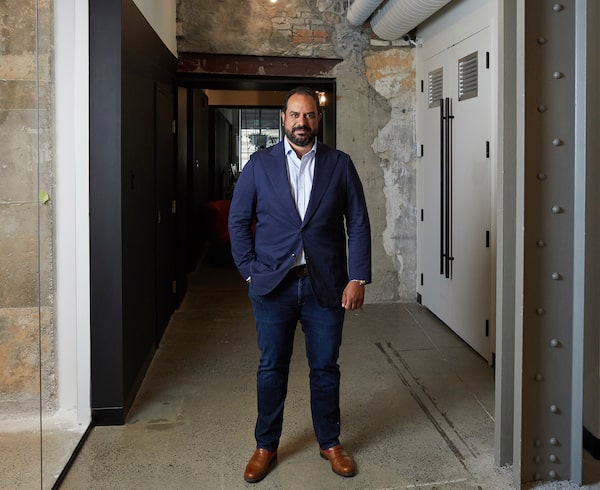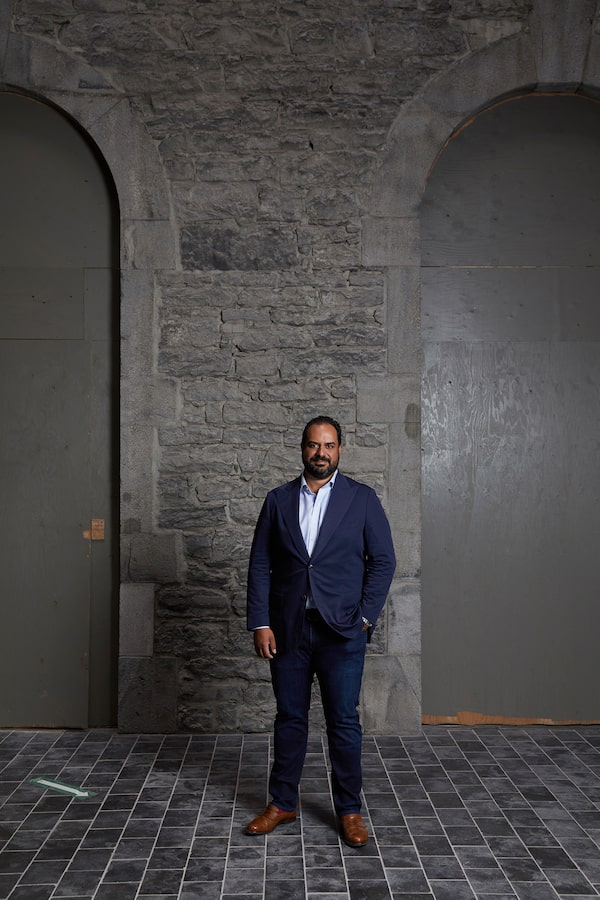
Riccardo Cellere/The Globe and Mail
Last December, the board of directors of the Montreal-based telemedicine company Dialogue met to discuss the challenges ahead in 2020. Specifically, how could the firm shift the perception of telemedicine from being an afterthought to the forefront of health care? Since its founding in 2016, Dialogue had worked hard to bolster telemedicine’s lacklustre reputation, but the team agreed change would take time. “We were hoping that telemedicine would go mainstream in Canada in five to seven years, maybe,” says Cherif Habib, co-founder and CEO.
But just three months after that meeting—well, you know.
As most businesses scrambled to stay afloat amid the pandemic, a lucky few saw an uptick in sales. Then there’s Dialogue, which scaled up to 10 times its previous size in four weeks. “We’ve added 600 new employees in 100 days,” says Habib.
Habib started Dialogue after earning a degree in computer science and a career inventing and selling medical devices. Until recently, it was a small firm that merged health care with technology to provide better telemedicine. You’re not alone if you hear the word telemedicine and automatically think it’s a variation on the provincially funded toll-free phone service that most Canadians can access, be it Telehealth in Ontario or Capital Health in Alberta.
Wherever you are, too often the call goes something like this: After an inevitably long queue, the caller is connected with a registered nurse. Now imagine, for example, this case study features a worrisome rash. The nurse is not a dermatologist and lacks the credentials for a definitive diagnosis. Even if they’re 99% sure it’s nothing to worry about, a diligent nurse will almost certainly err on the side of caution and suggest you see your doctor—or, if you’re particularly unlucky, head to the emergency room. Despite the best of intentions, health resources weren’t well deployed, the nurse’s skills weren’t used at all, and the patient ended up more anxious than before.
Here’s how Dialogue does it differently: That caller instead snaps a photo of the rash and uploads it to their account on the company’s app (or through a web browser). “A dermatologist on our team will look at it and say either, ‘No, don’t worry about it,’ or, ‘Yes, you need to be seen,’” explains Habib. If it’s the latter, Dialogue will then refer you to the right medical professional in your area and, even better, schedule your appointment. If you need a prescription, Dialogue can deliver it to your door. Two weeks later, they’ll follow up to make sure you’re better. “We’re lowering the barrier to access for people with not-so-serious ailments that they might otherwise ignore,” says Habib.
Still, as any doctor will tell you, many patients will procrastinate for months or even years before visiting a doctor—even if it’s a virtual trip. And there are other challenges in attracting online patients. Some are concerned with privacy; some struggle with the technology; some can’t imagine taking medical advice from an app. To expand the company, Dialogue’s sales team had to get creative.
Rather than sell directly to consumers, Dialogue instead partners with employers. The benefit of healthy employees is actually measurable in terms of engagement and productivity. For about $10 per employee per month, Dialogue promises reduced absenteeism, less presenteeism (working while sick) and fewer disability claims. The company used these incentives to steadily expand its client list.
And then came COVID-19. “Overnight we were thrust into the mainstream,” says Habib. “We went from offering a little-known concept to something the health minister is talking about on TV every day.”

Riccardo Cellere/The Globe and Mail
Telemedicine was long in the works and is here to stay, says Dr. Samantha Hill, president of the Ontario Medical Association. “A lot of patients are very well-served by telemedicine,” she says. “Think about single mothers or people who can’t take the day off work or people with lower mobility. Think about if you lived way up North and now have access to a specialist.”
And yet, as always, there are limitations. “You need good, high-speed internet. You need a computer or a smartphone, and you need to be tech-savvy,” says Hill And without buy-in from the government, you need to be employed by one of Dialogue’s clients. “Health care in Canada is supposed to be universal and equitable,” Hill notes.
Dialogue has had many conversations with governments across the country, but a partnership has yet to be made. In early March, as concerns began to rise in Canada about the novel coronavirus, the company launched a free service to provide accurate information. It’s called Chloe. “If you know how to text your friend, you already know how to use Chloe,” says Alexis Smirnov, Dialogue’s chief technology officer.
If you’re isolating in quarantine, Chloe will text you to check in and help monitor your symptoms. And the friendship goes both ways. Says Smirov: “We built a system that answers questions like, can I get COVID from my dog? Do I need to wash the vegetables I buy?”
Dialogue’s new 2020 challenge is keeping up with demand. Their office is empty, having gone entirely virtual weeks before the rest of us. Habib’s once-small staff is now mostly people he’s never met in person. “As CEO, I used to know everyone’s name,” he says. “All of a sudden there are more new people than old people.” In hopes to keep the small-business feel within his ever-bigger business, Habib has invested in what he calls a “playbook” to promote culture and cohesiveness as they continue to recruit across departments.
Dialogue has just surpassed 800 employees and 700 medical professionals, and due to increased need from patients, has hired more counsellors and mental health providers. Any lingering telemedicine stigma is gone, if only by necessity, and almost five million Canadian users—and counting—have embraced Dialogue’s virtual care.
Your time is valuable. Have the Top Business Headlines newsletter conveniently delivered to your inbox in the morning or evening. Sign up today.